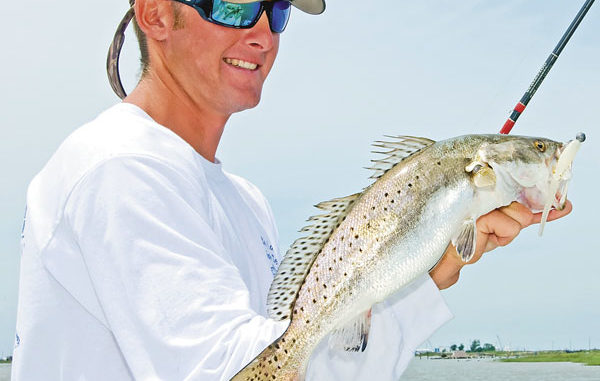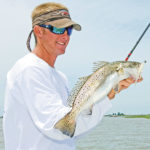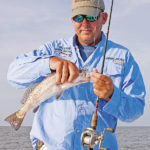
Whether you’re a Big Lake newbie or a salty old veteran, these 10 spots will put some lunkers in your box.
EDITOR’S NOTE: This is the second installment in a 12-part series mapping out hotspots along the Louisiana coast.The best day Capt. Nick Poe ever had on Calcasieu Lake was during February of last year. While wading with a friend, the two young anglers caught 30 trout over 4 pounds.
“Most were over 5,” he said. “It had been warm the week before, and the water temperature crept up to 67 degrees. The topwater bite usually doesn’t kick off until [the water temperature] hits 70, but those extra three degrees didn’t matter that day.”
Poe says they probably could have had the same kind of action had they fished from their boat. He recalled breaking off a Spook and having to wade back to his boat to tie on another one. A few quick casts out of the back confirmed what he thought he knew.
“There wasn’t anything special going on,” he said. “Those big trout were packed in that cove, and we happened to be in there with them at the right time. About the only thing I could say that might have influenced it was we were fishing as a big cold front was blowing through.”
Had they been a day later, they probably wouldn’t have caught a fish. And so it goes at Calcasieu Lake during February. There are times when the bite is so strong that anglers don’t even have to crank their big motors after stopping at their first spots.
But there are just as many, if not more, days when anglers have to move around the lake in a dizzying display of fishing 15 minutes then running 10 minutes. To be successful on those days, you’ve got to have a run-and-gun mentality.
“February is when the fishing really kicks off,” Poe said. “Some days you can fish one or two spots, and do well. Other days you’ve got to do a lot of running and fish a lot of spots. If you’re coming to Big Lake this month, be prepared to do both.”
• No. 1: Turner Bay Reef (N30 3’14.24” x W93 18’38.13”)
Where the northern-most part of Calcasieu Lake narrows down into Mud Lake, there is a small island just to the east of three large tanks on the western shoreline. Just north of this island is Turner Bay, and one of the bigger oyster reefs in the entire system lies between the island and the three tanks to the west.
A small pipeline channel to the west of the island and the old river to the east of the island makes this spot that much better because the deeper spots give trout a place to retreat. Poe considers the open portion of the reef to be a numbers hole, whereas he expects to catch larger trout closer to the island.
“You’ve got to fish this spot according to the wind,” he said. “For example, if you’ve got an east wind, start at the island and drift toward the tanks. You can cover the whole reef by drifting then slowing down wherever you pick up some bites.”
Since this spot is likely to be dirty during February, Poe said to stick with dark or glow soft plastics fished on 1/8- or 1/4-ounce lead heads. Bump the bottom with your baits as you drift, and fish them as slow as you can without getting hung.
• No. 2: Blue Camp (N30 1’29.82” x W93 16’15.96”)
This spot is a well-known wade-fishing hole, but those who don’t want to jump out of their boats can fare just as well. The reason so many wade anglers fish it is because it’s a big-trout spot. A line of rocks that runs from the northern point of the cut to the east toward the long pier in front of the blue camp is the signature feature of Poe’s second spot.
“The rocks are just in one long line,” Poe said. “They’re not wide — maybe 4 feet — but they come up from about 3 feet on the bottom to just a few inches under the surface. They’re shallow enough on top to knock your motor off.”
Trout spread out all along the old breakwater, but Poe says the entire flat around the rocks is good too because of its hard, sandy bottom. And because it is tucked up in the back of a semi-protected cove, the water stays relatively calm and clear with anything but a west wind.
While trying to be as quiet as possible so he doesn’t spook these shallow trout, Poe fishes suspending baits like Corkies, Catch 2000s and Storm Jointed Thundersticks around and over the rocks. He chooses 1/8- and 1/16-ounce lead heads rigged with big Norton Sand Eels when he turns to the plastics, and he’s had some success fishing the larger Storm and Tsunami soft-plastic swim baits.
• No. 3: Bois Connie Weir (N29 55’33.45” x W93 14’16.87”)
Love them or hate them, the reason the weirs get so crowded with anglers is that they always seem to hold fish. Seeing as how he doesn’t care where he catches fish, Poe doesn’t dismiss this first weir as he heads south.
This one is the deeper of the two weirs, and it’s as deep as 10 feet right out in the middle of the most turbulent water in front of the weir. Since the fish are generally in deep water with some strong current, Poe knows he has to fish his baits as slowly as possible to keep them in the strike zone.
“I throw a 1/4-ounce or maybe a 3/8-ounce lead head in here, and I cast right to the base of the structure,” Poe explained. “Then I just kind of bounce my Gulp all the way back to the boat. A lot of times, redfish will eat it right before you start pulling your bait up.”
If the middle of the weir is crowded with boats, Poe fishes the points on either side with the same chartreuse Gulp Swimming Mullet, and he expects to pick off some redfish and a few flounder. He also tries fishing the end of the current where the turbulent water starts to diminish.
• No. 4: Old Camp (N29 54’20.16” x W93 14’11.61”)
Here is where Poe and his friend caught 30 trout over 4 pounds. This area is basically just a flat on the east shoreline of Calcasieu Lake, but the added bonus of the foundation and piers of an old camp with some broken shoreline nearby make it a dynamite spot for trout and redfish.
“There are some old pilings in front of the camp that are under water,” Poe said. “Those pilings always seem to hold a few fish. I’ll try to pull a big fish off them with a suspending bait, but I also expand my area by drifting toward the point to the south.”
The area inside the cove and around the camp is a really hard bottom, but the farther out you go into the lake, the softer and muddier it becomes. Most times, the fish are on the hard bottom either inside the cove or around the transition into the muddy bottom. Another feature here is some broken hurricane debris that litters the bottom around the old camp.
Other than his suspending baits, Poe likes to fish the larger Sand Eels on 1/16-ounce lead heads because he wants his soft plastics to fall really slowly here. Redfish can hardly pass up a chartreuse Gulp Swimming Mullet tightlined on a 1/8- or 1/4-ounce lead head.
• No. 5: Grand Bayou Weir (N29 51’45.40” x W93 14’11.97”)
Not very far to the south of the Old Camp, anglers will find the second of the two weirs, and they are sure to find just as many anglers as they will fish. As it does at the first weir, an outgoing tide positions redfish on the lake side of the weir where they gorge on bait washing out of the marsh behind it. Poe says an incoming tide is best for flounder.
“Trout will also get in here during the spring,” he said, “but they stay out away from all the swift water and stack up behind the little island in front of the weir. The flounder will actually stack up right around the edges of this same island.”
Poe mainly sticks with his chartreuse Gulp soft plastic on a 1/4- or 3/8-ounce lead head because of the abundance of redfish and flounder around the weirs. However, he says that neither could pass up a shrimp fished on the bottom.
“Like the other weir, if the main part by the structure is full of boats,” Poe said, “you can poke around and work the banks outside the weir. This one has a longer canal to the south of the weir that will hold some fish, too.”
• No. 6: Pelican Cove (N29 50’49.23” x W93 20’17.78”)
What makes Pelican Cove so great is its proximity to the Ship Channel. When things are fresh all around the lake, the two points that lead into this pocket receive plenty of salty water due to the influence of the channel. The abundance of oysters between the two points doesn’t hurt either.
“The far point is really good on an outgoing tide,” Poe said. “The current makes a good ripple over there, and the trout will stack up in that ripple. The reef actually starts about half way between the two points, and it runs toward the point near the Ship Channel. They’ll get on top of it during an outgoing tide, too.”
Poe likes to hit the far point first before setting up on a drift over the reef to the Ship Channel point. Once he hits the Ship Channel point, he sets up and fishes it based on what the tide is doing. On an outgoing tide, he anchors on the Ship Channel side, but he moves to the inside of this same point on an incoming tide.
This can be a place to catch numbers of trout, but Poe says that plenty big trout come from Pelican Cove. For numbers, he fishes a Sand Eel on a 1/8-ounce lead head, and he switches to suspending baits for the larger trout.
• No. 7 – East Bank of West Cove (N29 51’37.19” x W93 21’17.39”)
Anglers will actually find two good options along the east bank of West Cove. The first is an existing reef that has been enhanced by LSU. A single pipe marks the location of the reef, and Poe says it’s a good spot to start for anglers not familiar with fishing Calcasieu. The second is the hard, sandy bottom that runs the length of the east bank for a couple hundred yards north of the reef.
“The bottom in this stretch is so hard it’s like walking on concrete,” said Poe. “And for whatever reason, it attracts a lot of baitfish. It gets a lot of sunshine, and with the sandy bottom, the water temperature creeps up later in the afternoon. Waders love this spot, but boat anglers should put it on the list of spots they have to fish.”
Poe targets the keeper trout around the reef with a Sand Eel tightlined on a 1/8-ounce lead head. The reef is about 5 feet on top of it, and he likes to fish all around the edges of the shells.
“When I move over to the sandy bank, I’m looking for a big trout,” he said. “That’s why I stick with the Corky or the jointed Thunderstick. You could also try the larger Sand Eel bumped on bottom here. Just keep in mind that West Cove isn’t that great on an outgoing tide because it’s not that deep, and it muddies up pretty quick.”
• No. 8: Trapper’s Camp (N29 51’0.98” x W93 25’41.19”)
Anybody interested in catching flounder should head to the southwest corner of West Cove, and look for the straight canal that has an old pier right at its mouth. Poe says this is a flounder hole that also holds a lot of redfish. Incoming tide positions both on the lip of a drop-off that is about 5 yards off the western bank.
“An incoming tide actually pulls water through the cut, and the flounder and redfish stack up all along this cut,” Poe explained. “I like to pull into the cut and anchor behind the pier with the front of my boat pointed back out to West Cove. Then I cast to the point on the other side and let the current take my bait along the drop-off.”
Poe throws the Glup Swimming Mullets here for the redfish and flounder, but he also mixes in the H&H grubs because they are such good flounder baits. If he sees any activity on top of the narrow flat, he tries a topwater for redfish.
• No. 9: Super Pocket (N29 54’30.00” x W93 19’57.49”)
It is extremely easy to drive right by the area that Poe called the Super Pocket without even giving it a second glance. However, this nondescript stretch of water is a great place to drift. While this is basically just a flat with a hard bottom, Poe says there are some shells right around the two obvious pipes that stick out of the water.
“The only problem here is that there won’t be enough water here to fish after a good cold front,” Poe said. “But when the water is on it, you can slam some big fish here. This is a lot of water, but you really don’t have to pick out a single spot and fish. Just drift until you get some bites, then stick around that spot a while.”
Suspending baits work well here for the larger trout during February, but Poe says bumping the bottom with a plastic fished on a 1/8-ounce lead head will get more bites. The most productive depth tends to be in that 2- to 3-foot range, but Poe added that the trout will sometimes get in the shallow water near the bank.
• No. 10 – Long Point Reef (N29 54’45.73” x W93 19’36.48)
While this spot is very close to Super Pocket, Poe says it is an entirely different scenario. Long Point Reef is a giant oyster reef that extends about 1/4 mile out into the lake, and it remains a uniform 6 feet across the reef. You could drift the entire reef, but Poe says he likes to set up on a drift on the inside edge of the reef.
“There’s a production platform north of Long Point,” Poe said, “and if you line those two up, you’ll be about the right distance off the bank. That platform’s not a permanent structure, but it’s been there about four years, so you should be able to use it. If not, get about 300 yards off the bank and drift toward the end of Long Point.”
Because it would require too much patience to fish a suspending bait in 6 feet of water, Poe routinely fishes a Sand Eel on a 1/8-ounce lead head along Long Point Reef. While he suggested February isn’t a great month to look for slicks, he said any that do pop up should get your immediate attention.
“Trout could be anywhere out on this giant reef,” Poe said, “but if you want to make sure you’re in the right spot, get on the inside edge of the reef. That’s the spot I’ve got marked on my GPS, and I only mark spots that have been good to me in the past.”
Capt. Nick Poe of Big Lake Guide Service can be reached at 337-598-3268.




